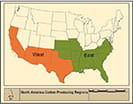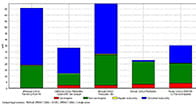Life Cycle Assessment Research and Resources
Life Cycle Assessment Research and Resources
According to Arkansas Farm Bureau, Arkansas ranks first among rice-producing states, accounting for more than 46 percent of U.S. rice production — primarily long and medium grain varieties. Rice production is concentrated in the eastern half of the state, stretching from Louisiana to the Missouri borders. Arkansas rice is known for its versatility and can be used in a wide variety of cuisines. It is enjoyed in the U.S. and throughout the world. However, rice production is a resource-intensive practice so sustainable production strategies must be developed and put in place. One of the sustainable production practices is called agricultural intensification, which can help meet current and future food security needs while decreasing environmental impacts. To date, no studies have simultaneously estimated the food security and environmental implications of previously adopted rice intensification regimes. Thus, research in this field is highly needed to continue to grow rice in a sustainable way. In the meantime, sustainability needs to be evaluated to support new and novel rice production practices. Therefore, Life Cycle Assessment (LCA) is the key to estimating the environmental impacts of both intensified and traditional rice systems. The researchers at the University of Arkansas System Division of Agriculture are conducting cutting-edge research to address these issues to support the Arkansas rice farmers in the sustainable production of rice.
 CARS is working with the World Cocoa Foundation to develop a conceptual framework for a LCA of cocoa production. The LCA will be based on production practices in West Africa, South Asia and South America. This conceptual framework will serve as a model for similar tropical crops, including palm oil, bananas, tea and coffee.
CARS is working with the World Cocoa Foundation to develop a conceptual framework for a LCA of cocoa production. The LCA will be based on production practices in West Africa, South Asia and South America. This conceptual framework will serve as a model for similar tropical crops, including palm oil, bananas, tea and coffee.
Contacts
Lanier Nalley • 479-575-6818 • llnalley@uark.edu
Carbon Life Cycle Assessment of United States Cotton: A View of Cotton Production Practices and their Associated Carbon Emissions for Counties in 16 Cotton Producing States
This study estimated the carbon-equivalent emissions (CE) from multiple agronomic production practices to produce one pound of cotton in the United States at county level resolution. Using a life cycle assessment approach, greenhouse gas (GHG) emissions were estimated from cradle to farm-gate. This analysis included GHG emissions from the manufacture of inputs, such as fertilizers and agrochemicals, as well as emissions from products themselves, such as diesel exhaust. Production practices included irrigated vs. non-irrigated, genetically modified vs. conventional varieties, and reduced vs. conventional tillage.
Results indicated that while there were significant differences in the amounts of inputs by production practice and hence the CE per acre by region of the country, CEs on a per yield basis were fairly constant. Generally, input intensive production practices resulted in much higher yields, and thus reduced overall CE per pound of cotton. Fertilizer and nitrogen in particular, contributed the largest portion of the carbon footprint. A significant portion of the carbon emissions was from nitrogen released as soil N2O. However, in regions that relied on irrigation, fuel use for pumping approached the level of emissions from fertilizer application. Developing methods to reduce soil N2O emissions could help reduce the impact significantly.
Contacts
Lanier Nalley, 479-575-6818, llnalley@uark.edu
 |
 |
 |
Final Project Report |
Methodology Presentation |
Presentation for MARS Inc. |
Energy Use Life Cycle Assessment for Global Cotton Production Practices
The goal of this project was to use Life Cycle Assessment (LCA) to quantify the energy required for cotton production over a range of global cotton production practices. Energy use is only one measurement of agricultural sustainability, but represents a method for unifying measurements of a variety of other inputs into agricultural production. The Center for Agricultural and Rural Sustainability at the University of Arkansas developed a model of energy usage by identifying a range of production practices across the globe and using these practices as parameters for the model. The LCA quantified various forms of energy inputs including direct mechanical, animal, and human energy required to produce a unit of raw cotton (expressed as a tonne or 1000 kg). The LCA also quantified energy embodied in the fertilizer, mechanical components and manure. The production of secondary products (seed, oil, etc.) was analyzed to quantify potential recoverable energy. The model quantifies energy used to perform various cotton production tasks including field preparation, planting, field operations and harvesting.
The average embodied energy of production of a tonne of cotton from the ten regions of the world ranges from 5,600 MJ/tonne (North America East) to 48,000 MJ/tonne (South America Non-Mechanized). The LCA of energy associated with use of manure as fertilizers in cotton production clearly demonstrated the large quantity of energy embodied in manure. Quantifying this opportunity cost (where manure energy can be practically utilized, e.g., using manure as a fuel for heating or cooking), increases the expressed embodied energy of cotton production of those systems almost tenfold. The LCA of net energy costs of production, measured as embodied energy minus potentially recovered energy (cottonseed oil and meal), showed that six of the ten regional production scenarios have the potential to be net energy-producing systems. The most sensitive variables for net energy production for cotton were yield and irrigation.
Contact
Marty Matlock, 479-575-2849, mmatlock@uark.edu
Evaluation of Toxicity in Cotton Production and Toxicity Impact Assessment Methods
This study attempted to assess toxicity of cotton under multiple production practices and to compare several toxicity assessment methods currently in use. Five methods were selected for this analysis (CML, Impact 2002 +, ReCiPe, and TRACI). These methods showed that no till cotton appears to reduce the toxicity of conventional cotton production. Additionally, dryland cotton appears to have lower toxicity than irrigated cotton. While all five of the impact methods provided index values for toxicity, only three were useful for comparison in this study. Both CML and TRACI were missing index values for roughly two thirds of the pesticides used in cotton production. Of the three methods used for final comparison, the pesticide rankings were fairly consistent between Impact 2002+ and ReCiPe, however EIQ did not correlate nearly so well with Impact 2002+ and ReCiPe.
Contact
Marty Matlock • 479-575-2849 • mmatlock@uark.edu
 CARS, in collaboration with the Applied Sustainability Center and the College of Engineering, is developing a Life Cycle Assessment(LCA) for greenhouse gas emissions related to liquid milk production. The LCA will be based on dairy production practices in the U.S. across five regions and three farm sizes. This is a “cradle to grave” analysis, ranging from feed production to packaging disposal by the consumer.
CARS, in collaboration with the Applied Sustainability Center and the College of Engineering, is developing a Life Cycle Assessment(LCA) for greenhouse gas emissions related to liquid milk production. The LCA will be based on dairy production practices in the U.S. across five regions and three farm sizes. This is a “cradle to grave” analysis, ranging from feed production to packaging disposal by the consumer.
Contacts
Jennie Popp • 479-575-2279 • jhpopp@uark.edu
Marty Matlock • 479-575-2849 • mmatlock@uark.edu
 CARS, in collaboration with the Applied Sustainability Center and the College of Engineering, is developing a sweet corn LCA that includes embodied energy, carbon- and water-footprint. The LCA is representative of sweet corn production practices in the U.S.
CARS, in collaboration with the Applied Sustainability Center and the College of Engineering, is developing a sweet corn LCA that includes embodied energy, carbon- and water-footprint. The LCA is representative of sweet corn production practices in the U.S.
Contacts
Lanier Nalley • 479-575-6818 • llnalley@uark.edu
Michael Popp • 479-575-6838 • mpopp@uark.edu
Resources
Energy Calculator Tools
Click here for a summary of energy calculators available on the world wide web. The calculators cover areas such as calculating greenhouse gas equivalents, estimating your personal carbon footprints, calculating potential home energy savings, determining energy use associated with farming operations, and more.
Life Cycle Assessment work at the University of Arkansas 2009
Life Cycle Assessment: A Simple Overview of a Complex Process
Click here for an overview of the LCA process, prepared by CARS and partner organizations.
Open Source LCI/LCA – White Paper
Click here for information on the Applied Sustainability Center’s Open Source LCI/LCA project. The Applied Sustainability Center, with input from CARS, is coordinating an open source LCI/LCA database to overcome cost and time burdens associated with life cycle studies. The open source database will foster collaborative data entry by all who wish to add value to the process.
Sustainable Agriculture and Life Cycle Assessment Presentation
Sustainable Metrics and LCA in Agriculture Current Sustainability Metrics Intuitives in Agriculture
News Items
BIG FOOT: In measuring carbon emissions, it’s easy to confuse morality and science
by Michael Specter, The New Yorker, February 25, 2008
Cooking The Carbon Books
by William Pentland, Forbes, October 13, 2008
Six Products, Six Carbon Footprints: Everybody’s talking about it. But what exactly is a carbon footprint? And how is it calculated?
by Jeffrey Ball, The Wall Street Journal, October 6, 2008





